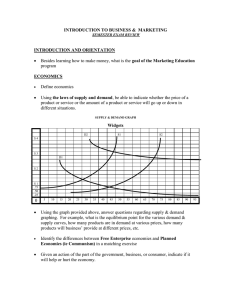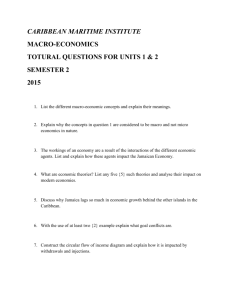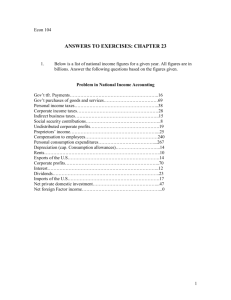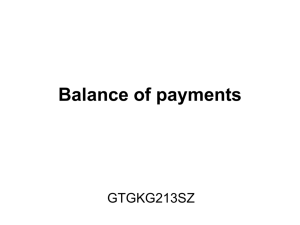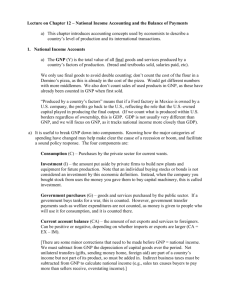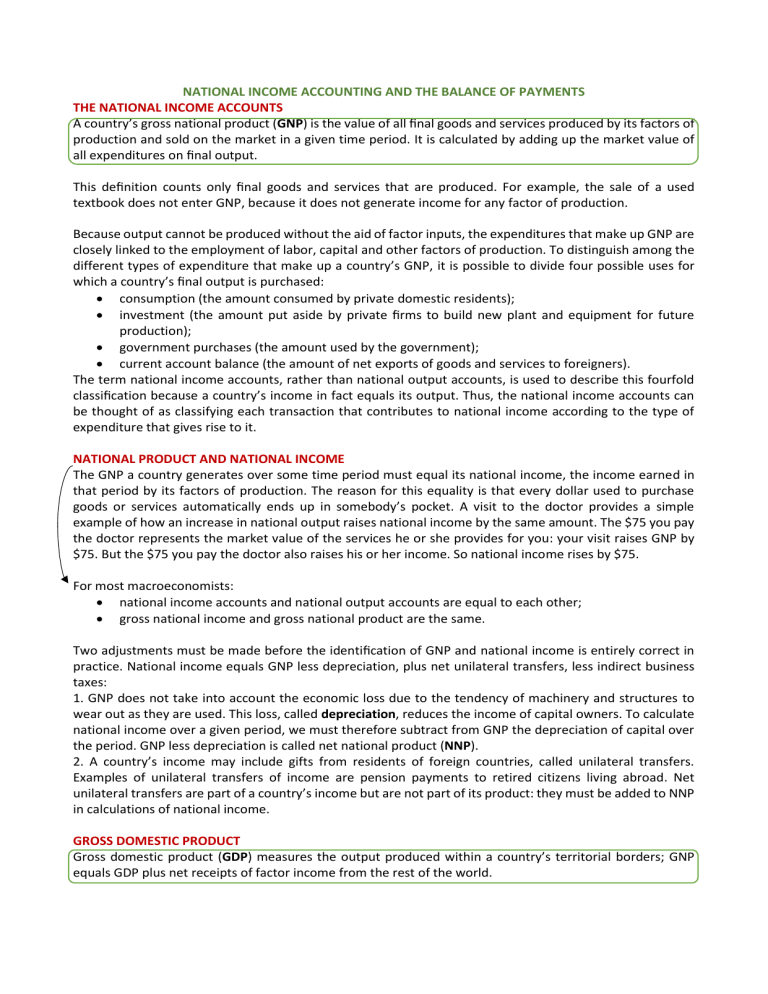
NATIONAL INCOME ACCOUNTING AND THE BALANCE OF PAYMENTS THE NATIONAL INCOME ACCOUNTS A country’s gross national product (GNP) is the value of all final goods and services produced by its factors of production and sold on the market in a given time period. It is calculated by adding up the market value of all expenditures on final output. This definition counts only final goods and services that are produced. For example, the sale of a used textbook does not enter GNP, because it does not generate income for any factor of production. Because output cannot be produced without the aid of factor inputs, the expenditures that make up GNP are closely linked to the employment of labor, capital and other factors of production. To distinguish among the different types of expenditure that make up a country’s GNP, it is possible to divide four possible uses for which a country’s final output is purchased: consumption (the amount consumed by private domestic residents); investment (the amount put aside by private firms to build new plant and equipment for future production); government purchases (the amount used by the government); current account balance (the amount of net exports of goods and services to foreigners). The term national income accounts, rather than national output accounts, is used to describe this fourfold classification because a country’s income in fact equals its output. Thus, the national income accounts can be thought of as classifying each transaction that contributes to national income according to the type of expenditure that gives rise to it. NATIONAL PRODUCT AND NATIONAL INCOME The GNP a country generates over some time period must equal its national income, the income earned in that period by its factors of production. The reason for this equality is that every dollar used to purchase goods or services automatically ends up in somebody’s pocket. A visit to the doctor provides a simple example of how an increase in national output raises national income by the same amount. The $75 you pay the doctor represents the market value of the services he or she provides for you: your visit raises GNP by $75. But the $75 you pay the doctor also raises his or her income. So national income rises by $75. For most macroeconomists: national income accounts and national output accounts are equal to each other; gross national income and gross national product are the same. Two adjustments must be made before the identification of GNP and national income is entirely correct in practice. National income equals GNP less depreciation, plus net unilateral transfers, less indirect business taxes: 1. GNP does not take into account the economic loss due to the tendency of machinery and structures to wear out as they are used. This loss, called depreciation, reduces the income of capital owners. To calculate national income over a given period, we must therefore subtract from GNP the depreciation of capital over the period. GNP less depreciation is called net national product (NNP). 2. A country’s income may include gifts from residents of foreign countries, called unilateral transfers. Examples of unilateral transfers of income are pension payments to retired citizens living abroad. Net unilateral transfers are part of a country’s income but are not part of its product: they must be added to NNP in calculations of national income. GROSS DOMESTIC PRODUCT Gross domestic product (GDP) measures the output produced within a country’s territorial borders; GNP equals GDP plus net receipts of factor income from the rest of the world. The United States began to report its gross domestic product (GDP) only since 1991. GDP does not account for a country's production using services provided by foreign-owned capital and labor. Consider an example. The earnings of a Spanish factory with British owners are counted in Spain’s GDP but are part of Britain’s GNP. The services British capital provides in Spain are a service export from Britain, therefore they are added to British GDP in calculating British GNP. At the same time, to figure Spain’s GNP, we must subtract from its GDP the corresponding service import from Britain. As a practical matter, movements in GDP and GNP usually do not differ greatly. The definition of GNP refers to goods and services generated by a country’s factors of production, but it does not specify that those factors must work within the borders of the country that owns them. NATIONAL INCOME ACCOUNTING FOR AN OPEN ECONOMY Since a closed economy’s residents cannot purchase foreign output or sell their own to foreigners, all of national income must be allocated to domestic consumption, investment or government purchases. In an economy open to international trade, however, the closed-economy version of national income accounting must be modified because some domestic output is exported to foreigners while some domestic income is spent on imported foreign products. CONSUMPTION The portion of GNP purchased by private households to fulfill current wants is called consumption. Purchases of movie tickets, food, dental work, and washing machines all fall into this category. Consumption expenditure is the largest component of GNP in most economies. In the United States, for example, the fraction of GNP devoted to consumption has fluctuated in a range from about 62 to 70 percent over the past 60 years. INVESTMENT The part of output used by private firms to produce future output is called investment. Investment spending may be viewed as the portion of GNP used to increase the nation’s stock of capital. Steel and bricks used to build a factory are part of investment spending, as are services provided by a technician who helps build business computers. Firms’ purchases of inventories are also counted in investment spending because carrying inventories is just another way for firms to transfer output from current use to future use. Investment is usually more variable than consumption. In the United States, (gross) investment has fluctuated between 11 and 22 percent of GNP in recent years. GOVERNMENT PURCHASES Any goods and services purchased by federal, state, or local governments are classified as government purchases in the national income accounts. Included in government purchases are federal military spending, government support of cancer research, and government funds spent on highway repair and education. Government purchases include investment as well as consumption purchases. Government transfer payments such as social security and unemployment benefits do not require the recipient to give the government any goods or services in return. Thus, transfer payments are not included in government purchases. Government purchases currently take up about 17 percent of U.S. U.S. has a negative current balance. Since all of a closed economy’s output must be consumed, invested or bought by the government, we can write Y=C+I+G where Y stand for GNP, C for consumption, I for investment, and G for government purchases. When foreign trade is possible, however, some output is purchased by foreigners while some domestic spending goes to purchase goods and services produced abroad. The GNP identity for open economies shows how the national income a country earns by selling its goods and services is divided between sales to domestic residents and sales to foreign residents. The goods and services purchased from abroad make up a country’s imports. The value of imports, denoted by IM, must be subtracted from total domestic spending, C + I + G, to find the portion that generates domestic national income: only the portion of spending that is not devoted to imports is part of domestic GNP. Similarly, the goods and services sold to foreigners make up a country’s exports. Exports, denoted by EX, are the amount foreign residents’ purchases add to the national income of the domestic economy. The national income of an open economy is therefore the sum of domestic and foreign expenditures on the goods and services produced by domestic factors of production. Thus, the national income identity for an open economy is: Y = C + I + G + EX – IM. THE CURRENT ACCOUNT AND FOREIGN INDEBTEDNESS Trade does not have to be balanced if the economy can borrow from and lend to the rest of the world. The difference between exports of goods and services and imports of goods and services is known as the current account balance (or current account). When a country’s imports exceed its exports, we say the country has a current account deficit. A country has a current account surplus when its exports exceed its imports. The current account is important because it measures the size and direction of international borrowing: it equals the country’s net lending to foreigners. When a country imports more than it exports, it is buying more from foreigners than it sells to them and must somehow finance this current account deficit. How does it pay for additional imports once it has spent its export earnings? Since the country as a whole can import more than it exports only if it can borrow the difference from foreigners, a country with a current account deficit must be increasing its net foreign debts by the amount of the deficit. This is currently the position of the United States, which has a significant current account deficit (and borrowed a sum equal to roughly 3 percent of its GNP in 2015). Alternatively, a country could finance a current account deficit by using previously accumulated foreign wealth to pay for imports. This country would be running down its net foreign wealth, which is the same as running up its net foreign debts. Similarly, a country with a current account surplus is earning more from its exports than it spends on imports. This country finances the current account deficit of its trading partners by lending to them. The foreign wealth of a surplus country rises because foreigners pay for any imports not covered by their exports by issuing IOUs that they will eventually have to redeem. This shows that a country’s current account balance equals the change in its net foreign wealth. The current account balance equals the difference between the economy’s output and its total use of goods and services: Y – (C + I + G) = CA. The sum A = C + I + G is often called domestic absorption in the literature on international macroeconomics. Using this terminology, we can describe the current account surplus as the difference between income and absorption, Y – A. It is only by borrowing abroad that a country can have a current account deficit and use more output than it is currently producing. If it uses less than its output, it has a current account surplus and is lending the surplus to foreigners. A country with a current account deficit is importing present consumption and exporting future consumption. A country with a current account surplus is exporting present consumption and importing future consumption. The figure gives a vivid illustration of how a string of current account deficits can add up to a large foreign debt. This figure plots the U.S. current account balance since the late 1970s along with a measure of the nation’s stock of net foreign wealth, its net international investment position (or IIP): it is the difference between its claims on foreigners and its liabilities to them. As you can see, a string of current account deficits starting in the 1980s reduced America’s net foreign wealth until, by the early 21st century, the country had accumulated a substantial net foreign debt. In 1989, the country became a net debtor to foreigners for the first time since World War I. That foreign debt has continued to grow, and at the end of 2016, it stood at just below 40 percent of GNP. In 2006, the United States had a deficit in the current account. SAVING AND THE CURRENT ACCOUNT The national saving is the portion of output, Y, that is not devoted to household consumption, C, or government purchases, G. By using current output to build plant, equipment and inventories, investment transforms present output into future output. For a closed economy, investment is the only way to save in the aggregate, so the sum of the saving carried out by the private and public sectors, national saving, must equal investment. This tells us that the closed economy can increase its wealth only by accumulating new capital. Let S stand for national saving: S = Y – C – G. Since the closed-economy GNP identity, Y = C + I + G, may also be written as I = Y – C – G, then S = I. Whereas in a closed economy saving and investment must always be equal, in an open economy they can differ. Remembering that national saving, S, equals Y – C – G and that CA = EX – IM, we can write: S = I + CA. The equation highlights an important difference between open and closed economies. An open economy can save either by building up its capital stock or by acquiring foreign wealth – through domestic and foreign investments –, but a closed economy can save only by building up its capital stock. Unlike a closed economy, an open economy with profitable investment opportunities does not have to increase its saving in order to exploit them. Because one country’s savings can be borrowed by a second country in order to increase the second country’s stock of capital, a country’s current account surplus is often referred to as its net foreign investment. Of course, when one country lends to another to finance investment, part of the income generated by the investment in future years must be used to pay back the lender. Domestic investment and foreign investment are two different ways in which a country can use current savings to increase its future income. PRIVATE AND GOVERNMENT SAVING Unlike private saving decisions, government saving decisions are often made with an eye toward their effect on output and employment. The national income identity can help us to analyze the channels through which government saving decisions influence macroeconomic conditions. Private saving is defined as the part of disposable income that is saved rather than consumed. Disposable income is national income, Y, less the net taxes collected from households and firms by the government, T. Private saving, denoted SP, can therefore be expressed as SP = Y – T – C. Government saving is defined similarly to private saving. The government’s income is its net tax revenue, T, while its consumption is government purchases, G. If we let SG stand for government saving, then SG = T – G. The two types of saving we have defined, private and government, add up to national saving. To see why, recall the definition of national saving, S, as Y – C – G. Then S = Y – C – G = (Y – T – C) + (T – G) = SP + SG. Because S = SP + SG = I + CA, SP = I + CA – SG= I + CA – (T – G) = I + CA + (G – T). This equation relates private saving to domestic investment, the current account surplus and government saving. We define the government budget deficit as G – T: it measures the extent to which the government is borrowing to finance its expenditures. The equation then states that a country’s private saving can take three forms: investment in domestic capital (I), purchases of wealth from foreigners (CA) and purchases of the domestic government’s newly issued debt (G – T). In a closed economy, the current account is always zero, so private saving, SP, is simply equal to I + (G – T). THE BALANCE OF PAYMENTS ACCOUNTS All transactions between a country and the rest of the world are recorded in the country’s balance of payments accounts. The balance of payments accounts is a detailed record of the composition of the current account balance and of the many transactions that finance it. A country’s balance of payments accounts keep track of both its payments to and its receipts from foreigners. Any transaction resulting in a receipt from foreigners is entered in the balance of payments accounts as a credit. Any transaction resulting in a payment to foreigners is entered as a debit. Three types of international transaction are recorded in the balance of payments: 1. Transactions that arise from the export or import of goods or services and therefore enter directly into the current account. When a French consumer imports American blue jeans, for example, the transaction enters the U.S. balance of payments accounts as a credit on the current account. 2. Transactions that arise from the purchase or sale of financial assets. An asset is any one of the forms in which wealth can be held, such as money, stocks, factories or government debt. The financial account of the balance of payments records all international purchases or sales of financial assets. When an American company buys a French factory, the transaction enters the U.S. balance of payments as a debit in the financial account. The difference between a country’s purchases and sales of foreign assets is called its financial account balance, or its net financial flows. 3. Certain other activities resulting in transfers of wealth between countries are recorded in the capital account. These international asset movements differ from those recorded in the financial account. For the most part they result from nonmarket activities or represent the acquisition or disposal of nonproduced, nonfinancial and possibly intangible assets (such as copyrights and trademarks). Every international transaction automatically enters the balance of payments twice, once as a credit and once as a debit. This principle of balance of payments accounting holds true because every transaction has two sides: if you buy something from a foreigner, you must pay him in some way and the foreigner must then somehow spend or store your payment. THE FUNDAMENTAL BALANCE OF PAYMENTS IDENTIFY Because any international transaction automatically gives rise to offsetting credit and debit entries in the balance of payments, the sum of the current account balance and the capital account balance automatically equals the financial account balance (net financial flows): CURRENT ACCOUNT + CAPITAL ACCOUNT = FINANCIAL ACCOUNT. This feature of the accounts reflects the fact that discrepancies between export earnings and import expenditures must be matched by a promise to repay the difference, usually with interest, in the future. Because the sum of the current and capital accounts is the total change in a country’s net foreign assets (including, through the capital account, nonmarket asset transfers), that sum necessarily equals the difference between a country’s purchases of assets from foreigners and its sales of assets to them— that is, the financial account balance (also called net financial flows). The balance of payments accounts divides exports and imports into three finer categories. The first is goods trade, that is, exports or imports of merchandise. The second category, services, includes items such as payments for legal assistance, tourists’ expenditures and shipping fees. The final category, income, is made up mostly of international interest and dividend payments and the earnings of domestically owned firms operating abroad. Wages that workers earn abroad can also enter the income account. We include income on foreign investments in the current account because that income really is compensation for the services provided by foreign investments. The earnings of capital and labor working abroad are referred to as primary income. In discussing the relationship between GNP and national income, we defined unilateral transfers between countries as international gifts, that is, payments that do not correspond to the purchase of any good, service or asset (secondary income). Net unilateral transfers are considered part of the current account as well as a part of national income: the identity Y = C + I + G + CA holds exactly if Y is interpreted as GNP plus net transfers. STATISTICAL DISCREPANCY If every balance of payments credit automatically generates an equal counterpart debit and vice versa, how is this difference possible? The reason is that information about the offsetting debit and credit items associated with a given transaction may be collected from different sources. Because data from different sources may differ in coverage, accuracy, and timing, the balance of payments accounts seldom balance in practice as they must in theory. Account keepers force the two sides to balance by adding to the accounts a statistical discrepancy item. We have no way of knowing exactly how to allocate this discrepancy among the current, capital, and financial accounts. In addition, balance of payments accountants consider merchandise trade data relatively reliable, but data on services are not. Service transactions such as sales of financial advice and computer programming assistance may escape detection. Accurate measurement of international interest and dividend receipts is particularly difficult OFFICIAL RESERVE TRANSACTION Although there are many types of financial account transactions, one type is important enough to merit separate discussion. This type of transaction is the purchase or sale of official reserve assets by central banks. An economy’s central bank is the institution responsible for managing the supply of money. In the United States, the central bank is the Federal Reserve System. Official international reserves are foreign assets held by central banks as a cushion against national economic misfortune. At one time, official reserves consisted largely of gold, but today, central banks’ reserves include substantial foreign financial assets, particularly U.S. dollar assets such as Treasury bills. Central banks often buy or sell international reserves in private asset markets to affect macroeconomic conditions in their economies. Any central bank transaction in private markets for foreign currency assets is called official foreign exchange intervention. One reason why foreign exchange intervention can alter macroeconomic conditions is that it is a way for the central bank to inject money into the economy or withdraw it from circulation. Government agencies other than central banks may hold foreign reserves and intervene officially in exchange markets. When a central bank purchases or sells a foreign asset, the transaction appears in its country’s financial account just as if the same transaction had been carried out by a private citizen. The level of net central bank financial flows is called the official settlements balance or the balance of payments. This balance is the sum of the current account and capital account balances, less the nonreserve portion of the financial account balance; it indicates the payments gap that official reserve transactions need to cover. The balance of payments played an important historical role as a measure of disequilibrium in international payments, and for many countries it still plays this role. A country has a deficit in its balance of payments when it is running down its official international reserves or borrowing from foreign central banks; it has a surplus in the opposite case.
